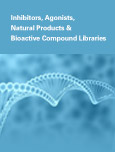| Cat. No. |
Product Name |
Information |
| PC-45780 |
PF-CBP1 hydrochloride
CBP/p300 inhibitor
|
PF-CBP1 hydrochloride is a potent, highly selective inhibitor of the CBP and p300 bromodomains with IC50 of 125 nM and 363 nM, respectively. |
| PC-42090 |
GSK6853
BRPF1 inhibitor
|
GSK6853 (GSK-6853) is a potent, highly selective and cell-active BRPF1 bromodomain inhibitor with TR-FRET pIC50 of 8.1. |
| PC-42168 |
CPI-637
CBP/p300 inhibitor
|
CPI-637 is a potent and selective, cell-active CBP/EP300 bromodomain inhibitor with CBP BRET EC50 of 0.03 uM. |
| PC-43808 |
I-BET726
BET inhibitor
|
I-BET726 (GSK1324726A) is a potent and selective inhibitor of BET bromodomain with IC50 of 41 nM/31 nM/22 nM for BRD2/BRD3/BRD4 respectively. |
| PC-42230 |
TPOP146
CBP/p300 inhibitor
|
TPOP146 is a potent and selective CBP/p300 bromodomain inhibitor with Kd of 134 nM for CBP bromodomain, displays excellent selectivity over other bromodomains (>30-fold over BRD4 (1)). |
| PC-42029 |
Mivebresib
BET inhibitor
|
Mivebresib (ABBV-075) is a potent and orally available BET bromodomain inhibitor with Ki of 1.0, 12.2, 1.5, and 2.2 nM for BRD2, BRD3, BRD4 and BRDT, respectively. |
| PC-25803 |
PBRM1-BD2 inhibitor 34
PBRM1-BD2 inhibitor
|
PBRM1-BD2 inhibitor 34 (PBRM1-BD2-IN-8) is a potent, selective PBRM1 bromodomain inhibitor with Kd of4.4 uM, IC50 of 0.16 uM for PBRM1-BD2, shows promising inhibition toward PBRM1-dependent prostate cancer cell line LNCaP with IC50 of 9 uM. |
| PC-25802 |
PBRM1 inhibitor PB16
PBRM1-BD2 inhibitor
|
PBRM1 inhibitor PB16 is a selective, cell-active Polybromo-1 (PBRM1) bromodomain inhibitor with ITC KD of 2 uM for PBRM1-BD2, and IC50 of 0.26 uM in AlphaScreen assays. |
| PC-25799 |
DLG-41
GAS41 YEATS domain inhibitor
|
DLG-41 is a potent, selective inhibitor of GAS41 YEATS domain with IC50 of 610 nM in in AlphaLISA assays, binds to GAS41 YEATS domain with ITC KD of 1.0 uM. |
| PC-25104 |
Zavabresib
BET inhibitor
|
Zavabresib is a potent BET inhibitor with anticancer activity, inhibits prostate cancer cell growth with IC50 of 0.043 and 0.034 μM against LNCaP and 22Rv1 cells, respectively. |
| PC-24390 |
Y08197
CBP/EP300 inhibitor
|
Y08197 is a selective inhibitor of CBP/EP300 bromodomain, inhibits the CBP bromodomain with IC50 of 100.67 nM, high selectivity for CBP/EP300 over other bromodomain-containing proteins. |
| PC-24237 |
KB-0118
BET bromodomain
|
KB-0118 is a selective BET bromodomain inhibitor with Kd of 36.7 uM for BRD2 BD1 and 47.4 uM for BRD4 BD1, shows immunomodulatory effects in inflammatory bowel disease (IBD). |













